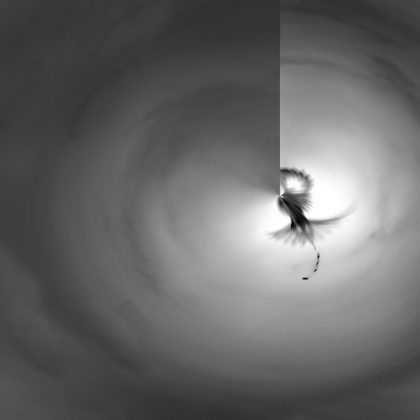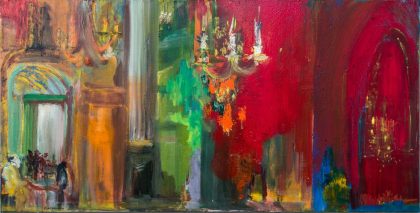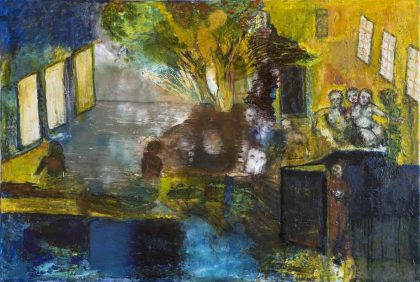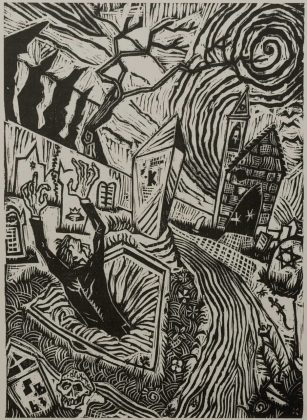The Saphir Gallery has been an essential part of Jewish artistic life for nearly half a century. It is above all the work of Elie and Francine Szapiro. A couple involved in (re)discovering and sharing a cultural heritage that refuses to be lost, despite the blows of history. Confirmed artists and revelations, so many were exposed on the first floor of the gallery or in the basement which is an architectural work in itself, dating back several centuries. Francine Szapiro welcomes us, evoking the genesis of the gallery, but also its contemporary role. In particular in the context of the European Days of Jewish Culture, with the exhibition “Plastician struggles: tribute to Ukraine”.

Jguideeurope: How was the Saphir Gallery born?
Francine Szapiro: In 1979, I was a journalist with a passion for art, working for the Ark, the Jewish Telegraphic Agency and other media. My husband was a doctor with a passion for history and a founding member of the French Commission for Jewish Archives. In this period of Jewish cultural reconstruction, we had the common dream of opening a gallery where all aspects of this culture would be presented, its manifestations, ritual objects and ancient books… without enclosing it in a ghetto, motivated by the desire to show the reciprocal contribution of the surrounding cultures.
Who were the first artists to be exhibited?
There were so many! My husband and I were passionate about sharing our favorites and discoveries in a place where we could meet and exchange. And the dream finally came true. Our first gallery was located on the boulevard Saint-Germain, and was inaugurated by Elie Wiesel with an exhibition on postcards and Judaism to show the diversity of the Jewish world. We began by exhibiting Alain Kleinmann, then Shelomo Selinger. This small 15 m² gallery has hosted many other large events since then.

How do you perceive the evolution of interest in Jewish art?
I would love to be able to sit down one day and tell this story in detail. My husband and I were part of the generation that wanted to rebuild a heritage that had been destroyed or dispersed during the war. We knew at the time great collectors like Victor Klagsbald, who is the father of Laurence Sigal, the former director of the mahJ. In the aftermath of the war, these collectors searched everywhere for evidence of Jewish life in the past, at the flea market or in other sales places. My husband organized the first international judaica sale. People then realized that it could have a market value, and saved pictorial and written objects from loss and destruction. Thus, we have seen two generations in the gallery. The one of those who wanted to reconstruct the dispersed life, then the one who wished to affirm its insertion in the century, the will of integration and assimilation, moving away a little from this quest at all costs of traces. This did not prevent some young people from being very interested and involved in the search for the Jewish cultural heritage. This desire was particularly evident during the European Days of Jewish Culture. This European desire to gather is very important. We have had the pleasure of participating in these days since the beginning.

During the EDJC 2022, Ukraine is in the spotlight at the Saphir gallery.
We presented the exhibition “Plastician struggles” just before the summer with various artists that we will resume. Among them, the writer Hubert Haddad who we discover as a painter impregnated with Kabbalah or Bruno Edan, artist who died in 1981 at the age of 23 and to whom the art historian Delphine Durand has devoted a magnificent monograph. Three artists of Ukrainian origin also participate. Serge Kantorowicz, who was a refugee in France during the war, and who lost a large part of his family in Ukraine during the Shoah.

He rebuilt himself through painting, working in the Maeght studios where he made friends with great artists. Sam Szafran is his cousin. Serge has developed a very poetic and personal world that leaves the traditional representations. We also welcomed to the gallery the work of Igor Pototsky, a Ukrainian refugee we met recently, considered a great writer, poet and illustrator. And finally the young Ukrainian artist Yana Bystrova. This artist is going through difficult times, not knowing what happened to her works that were left in Kiev for an exhibition. Many Ukrainian artists and writers come to us, souls in pain who try to find links. Other artists are presented during this exhibition.

Among them, Sergio Birga, who died a year ago. A Florentine who went to meet the great German, Austrian and Belgian expressionists who had survived the Holocaust. He immersed himself for 50 years in the world of Kafka, building a very expressionist work around the writer. Birga was also a great wood engraver.
So we wanted to break down the fields of creation between engraving, sculpture, painting and even photography. By presenting, for example, the works of the contemporary photographer Jorge Amat, author of a beautiful film on Serge Kantorowicz and many others on art and cinema. Not to mention the work of Michel Kirch, son of a rabbi, whose work is the testimony of a quest for identity and spirituality.
The gallery is above all a place of encounters, reunions and sharing of a Jewish culture, and in the context of this exhibition it celebrates the vitality of a fighting Ukraine.
Saphir Gallery, 69 rue du Temple, 75003 Paris
Other events organized in Paris during the European Days of Jewish Culture:
“Ukraine and its borders” on September 4 at the mahJ
“Promenade through yiddish culture” on September 18 at the Maison de la culture yiddish
“Exilonde” on October 16 at the Comédie Nation Theatre
“Musical Conference on Klezmer” on October 18 at the Medem Center
“Letter to Antonio Saura” on November 24 at the Cervantes Institute